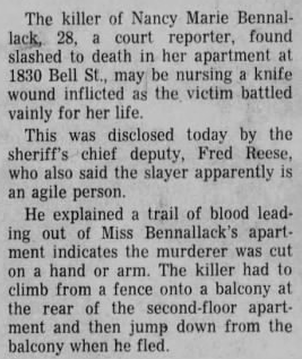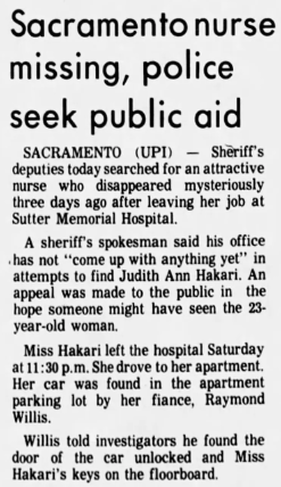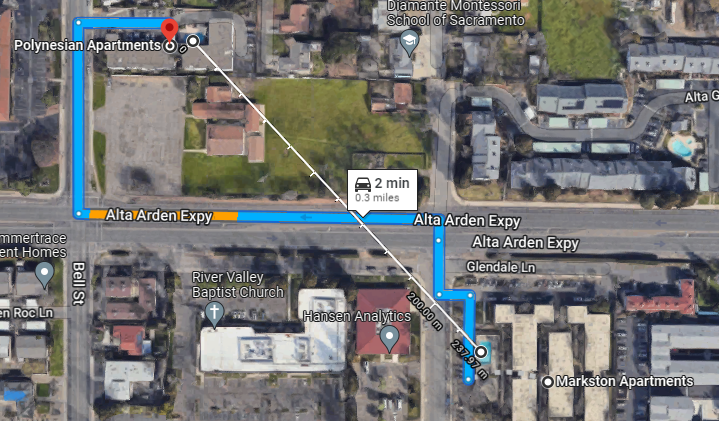
The rape and murder of 9-year-old Marise Ann Chiverella on March 8th 1964 in Hazleton, Pennsylvania was finally solved in 2022, when her killer was identified as James Paul Forte using semen stains from the jacket of the young girl. Forte, 22 years of age at the time of the murder, was a bartender in the area, who abducted the young girl as she made her way to school with canned goods for her teacher, who subsequently dumped her lifeless body in a coal-mining pit. This crime, solved by genetic genealogy, predated the case of Nancy Bennallack, but by no means is the oldest case solved using this crime-fighting DNA tool as the Patricia Kalitzke and Duane Bogle double murder case in 1956 showed.
The murder of 28-year-old court reporter Nancy Bennallack on October 25/26th 1970 was recently solved using genetic genealogy, identifying Richard John Davis who lived in the same apartment complex, as her killer. Stabbed more than 30 times and nearly decapitated, it is a reasonable assumption that Davis realized Nancy Bennallack's fiance had left her apartment that night at 11:30pm and noticed that she had left her second story balcony window open, which he accessed by scaling from beneath. Genetic genealogy was only possible in this case because investigators realized that a trail of blood from Nancy Bennallack's apartment to the parking lot, where it ended, had a strong possibility of being secreted by her murderer. A similar trail of blood was mentioned by investigators in the case of Cheri Jo Bates, that bridged the body and Terracina Drive in Riverside, and noticed by responding officers on October 31st 1966. A blood trail distance of approximately 100 feet, unlikely to have been deposited by a dripping knife measuring 3 1/2 inches long and half an inch wide. The blood typing of Cheri Jo Bates detailed at autopsy of AB RhD positive is rare, accounting for only 3.4% of the American population. If this blood trail had been sampled and tested (as it should have been), then not only would it have been easy to determine whether the blood was shed by the killer or Cheri Jo Bates, but we would have ample material (if stored correctly) to apply genetic genealogy to this case as well.
The murder of 28-year-old court reporter Nancy Bennallack on October 25/26th 1970 was recently solved using genetic genealogy, identifying Richard John Davis who lived in the same apartment complex, as her killer. Stabbed more than 30 times and nearly decapitated, it is a reasonable assumption that Davis realized Nancy Bennallack's fiance had left her apartment that night at 11:30pm and noticed that she had left her second story balcony window open, which he accessed by scaling from beneath. Genetic genealogy was only possible in this case because investigators realized that a trail of blood from Nancy Bennallack's apartment to the parking lot, where it ended, had a strong possibility of being secreted by her murderer. A similar trail of blood was mentioned by investigators in the case of Cheri Jo Bates, that bridged the body and Terracina Drive in Riverside, and noticed by responding officers on October 31st 1966. A blood trail distance of approximately 100 feet, unlikely to have been deposited by a dripping knife measuring 3 1/2 inches long and half an inch wide. The blood typing of Cheri Jo Bates detailed at autopsy of AB RhD positive is rare, accounting for only 3.4% of the American population. If this blood trail had been sampled and tested (as it should have been), then not only would it have been easy to determine whether the blood was shed by the killer or Cheri Jo Bates, but we would have ample material (if stored correctly) to apply genetic genealogy to this case as well.

Richard John Davis and Nancy Bennallack may have crossed paths many times, as they were both resident at the Tahitian apartment complex at 1830 Bell Street in Sacramento. When Richard John Davis became fixated on Nancy Bennallack is unknown, but they would have shared a communal pool had either of them chosen to use it. Why Davis chose to attack Nancy is also unknown, but it doesn't require great speculation that a sexual motive was the likely driver that night. His choice of placing masking tape over his fingertips clearly indicated this was a premeditated attack requiring some forethought. The idea that Davis may have set his sights on Miss Bennallack possibly days or weeks in advance of the crime, with some preparation, along with the observable blood trail ending in the parking lot of the Tahitian apartment complex, is not incongruent to the attack on Judith Hakari approximately 7 1/2 months earlier. If Davis set his sights on Bennallack, he could have set his sights on Hakari, who lived at the 1740 Markston Road apartments. The communal pool at the Markston apartments sits just 760 feet from the communal pool at the Tahitian apartments.
On March 7th 1970, Judith Hakari (23) left her job at the Sutter Memorial Hospital at 11;30pm, likely arriving in her Mercury Cougar at the parking lot of the Markston apartments at 11:45pm, from where she was immediately abducted. This may be the same time that Richard John Davis began his attack on Nancy Bennallack, shortly after her fiance left the second floor apartment on October 25th 1970. The walk for Judith Hakari from her vehicle to the door of her Markston Road apartment was a matter of seconds, so the likelihood of a random killer just happening upon the young 23-year-old in this small window of time is unlikely. This is further negated because her Mercury Cougar interior was scattered with torn strips of Cannon-brand towel, strongly suggestive of an abduction with premeditation and a second vehicle.
The idea that a pretty 23-year-old nurse traveling to and from Sutter Memorial Hospital at set times, could become the target of a pre-planned abduction by a perpetrator or perpetrators, who ruminated in the days or weeks before the abduction, is not without merit. One individual (or multiple) fixating on Judith Hakari, just like Richard John Davis may have in the case of Nancy Bennallack is a reasonable hypothesis. His original intention could have been the abduction (and possibly torture) of Nancy Bennallack, before something changed the dynamics of that crime (possibly his injury). The fact that his blood trail ceased in the parking lot and not his front door, could suggest a vehicle was waiting in the parking lot of the Tahitian apartment compex, with or without accomplices. It is perfectly conceivable that the actions of Nancy Bennallack prevented her from being abducted to a second location, that ultimately befell Judith Hakari several months earlier.
PART ONE
On March 7th 1970, Judith Hakari (23) left her job at the Sutter Memorial Hospital at 11;30pm, likely arriving in her Mercury Cougar at the parking lot of the Markston apartments at 11:45pm, from where she was immediately abducted. This may be the same time that Richard John Davis began his attack on Nancy Bennallack, shortly after her fiance left the second floor apartment on October 25th 1970. The walk for Judith Hakari from her vehicle to the door of her Markston Road apartment was a matter of seconds, so the likelihood of a random killer just happening upon the young 23-year-old in this small window of time is unlikely. This is further negated because her Mercury Cougar interior was scattered with torn strips of Cannon-brand towel, strongly suggestive of an abduction with premeditation and a second vehicle.
The idea that a pretty 23-year-old nurse traveling to and from Sutter Memorial Hospital at set times, could become the target of a pre-planned abduction by a perpetrator or perpetrators, who ruminated in the days or weeks before the abduction, is not without merit. One individual (or multiple) fixating on Judith Hakari, just like Richard John Davis may have in the case of Nancy Bennallack is a reasonable hypothesis. His original intention could have been the abduction (and possibly torture) of Nancy Bennallack, before something changed the dynamics of that crime (possibly his injury). The fact that his blood trail ceased in the parking lot and not his front door, could suggest a vehicle was waiting in the parking lot of the Tahitian apartment compex, with or without accomplices. It is perfectly conceivable that the actions of Nancy Bennallack prevented her from being abducted to a second location, that ultimately befell Judith Hakari several months earlier.
PART ONE
